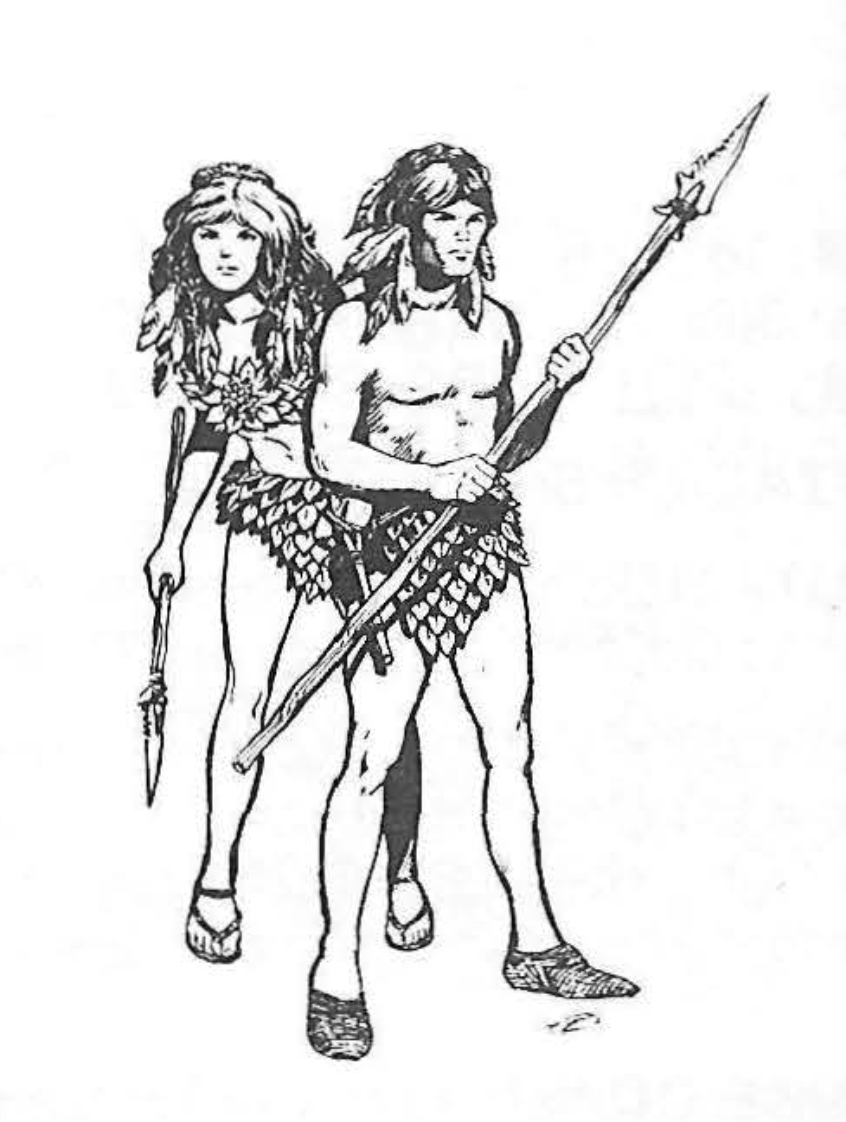Green Man «Gren»

Creature Metadata
- Reported By
- James M. Ward and Gary Jaquet
- Source
- 1st Edition
- Role
- Race
- Base Stock
- Human
- MCC Stat Block
- Gren 'Green Man' (1d8 (4)): Init +9; atk weapon melee +6 (1d10+2); AC 16; HD 15D5 hp 45 each; MV 30' ; 1d20+1d20; SV Fort +1, Ref +1, Will +2
- Mutations
- None
Combat & Physical Stats
- Number Appearing
- 1d8
- Morale
- 13
- Hit Dice
- HD 15D5
- Armor
- 6 (AC 16)
- Size
- Medium 2 Meter
- Movement
- MV 30'
- Attack
- Weapon melee +6 (1d10+2)
Ability Scores
- MS:
- 16
- PS:
- 16
- IN:
- 15
- DX:
- 15
- CH:
- 13
- CN:
- 15
Ecology & Logistics
- Frequency
- Common
- Organization
- Tribal
- Activity Cycle
- Night
- Diet
- Omnivore
- Habitat
- Temperate / tropical forest
- Tech Level
- 1 - 2
- Artifacts
- None
Description (Initial Observations): Grens look like Green skinned pure strain humans. However, Grens are mutant humans with entirely green skin, hair, and eye pigment due to their photosyntheic skin. They have no body hair except on their heads and tend to wear little clothing so that light can reach their skin.
Description (Additional Observations): Grens look like pure strain humans except for their dark green skin. Hair color ranges from brown to green, though a few rare individuals have blond hair. Grens wear a minimum of clothing, usually something made from leaves and grass.
Behavior & Society
- Reactions
- No known interactions
- Behavior
- Grens hate ancient technology and never keep artifacts. They carry Tech Level 1 gear. They don't use armor. They live at peace with nature, and shun outsiders desiring a peaceful existence. They will help PSH 30% of the time. A community consists of 1d6 * 20 occupants. They are guarded by 1d6 domesticated Blackuns, gators, Kai Lins, or Obbs for every 10 grens. Grens keep Ert Teldens as Catapult ammunition. When away from their community, they are not accompanied by their guardians.
- Repair & Healing
- Behavior not recorded
- Society
- Grens are normally nomadic, living as simple hunter-gatherers in forests and jungles. Some tribes have settled and expanded, however. These communities consist of 20-80 (1d4 X 20) members. Communities form only in very isolated areas. Settled grens still hunt and gather food, but they also tend any food plants which grow within their communities. They are careful to not harm the local ecology, trying to hvc in harmony with nature. Grens are also remarkably adept with animals and can train even the most stubborn of creatures, such as gators. This training ability also applies to semi-intelligent plants and funguses Creatures are domesticated solely for the use of the community and are never kept as personal guardians or pets. Grens are very insular but sometimes help friendly pure strain humans.Gren villages are primitive and they disdain all but Gamma Age technology. Since they don't need to hunt or farm for their food, their day-to-day life is fairly idyllic, save for warding off predators and other hazards. They often build their homes among the treetops, away from the dangers on the forest floor.
Additional Creatures
0th Edition - Metamorphosis Alpha
1st Edition
2nd Edition
3rd Edition
4th Edition
5th Edition
6th Edition
6th Edition - Beyond the Horizon
6th Edition - Machines & Mutants
Badder to the Bone
Badder to the Bone II
Dragon 98 - Ares Section June 1985 - GW2
Dragon Magainze 085
Dragon Magainze 130
Dragon Magazine 075
Dragon Magazine 098
Dragon Magazine 104
Dragon Magazine 108
Dragon Magazine 113
Dragon Magazine 126
Dragon Magazine 130
Famine at Fargo 7th Edition
GW01 - The Legion of Gold
GW02 - Famine in Far-Go
GW03 - The Cleansing War of Garik Blackhand
GW04 - The Mind Masters
GW05
GW05 - Rapture of the Deep
GW06 Module
GW06 Module, MM2
GW07 Module
GW08 Module
GW09 Module
GW10 Module
METAMORPHOSIS ALPHA TO OMEGA ADVENTURE 1: The Quest for Elvis
MM2
Master's of the Earth Campaign: MA-1 The Trials
Master's of the Earth Campaign: MA-4 To the Rescue
Master's of the Earth Campaign: MA-5 The Savage Beast
Master's of the Earth Campaign: MA-6 City of the Ancients
Masters of the Earth Campaign: MA-2 The Town of Boze
Mud Glat Walker
Omega Project
Paths of the Lil in White Dwarf
Polyhedron 02
Polyhedron 03
Polyhedron 10
Polyhedron 14
Polyhedron 144
Polyhedron 15
Polyhedron 27
Polyhedron 44
Ted Tschopp
The Albuquerque Starport
The Barracks Raid
There will be War
Trouble in Freesboro
White Wolf: Midnight in the Mystery Garden
Webmentions
Connect your blog or website to this post via Webmentions. Link to this article and your response will appear below, fostering a web-wide discussion. Supports comments, likes, and reposts from any Webmention-enabled site.